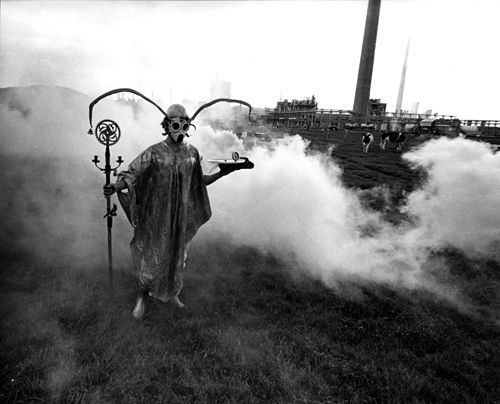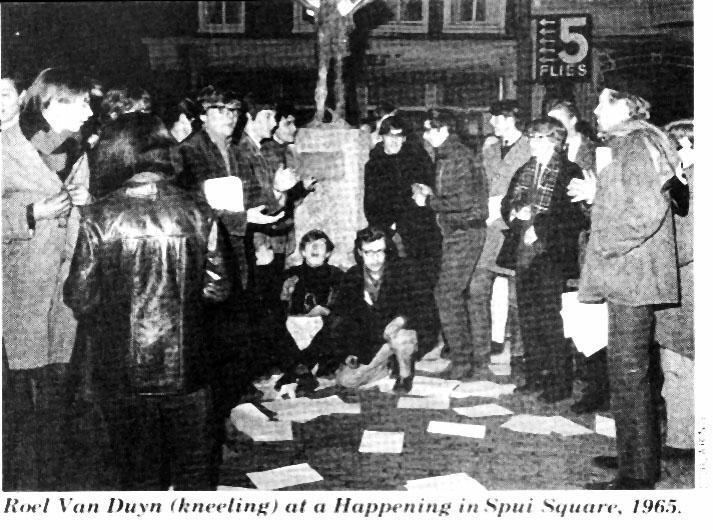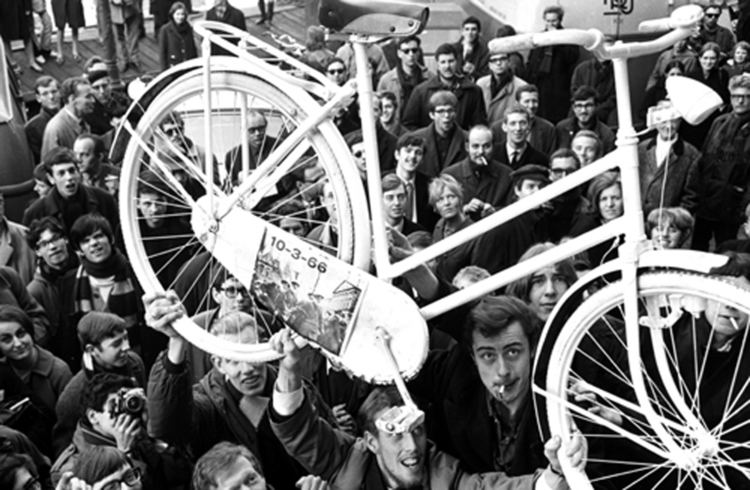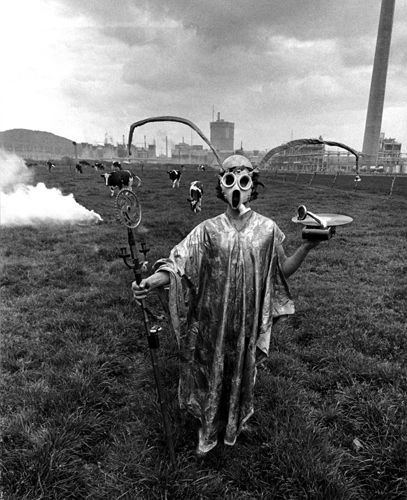 | ||
Provo was a Dutch counterculture movement in the mid-1960s that focused on provoking violent responses from authorities using non-violent bait. It was preceded by the nozem movement and followed by the hippie movement. Provo was founded, on 25 May 1965, by Robert Jasper Grootveld, an anti-smoking activist, and the anarchists Roel van Duijn and Rob Stolk. The term was used for the movement as a whole and for individual members. Provo was officially disbanded on 13 May 1967.
Contents
- Beginnings
- Magazine
- Actions and ideas
- Provoking the police
- The White Plans
- End
- After Provo
- Influence
- References

Beginnings
The Provos are thought to have evolved out of the artist Robert Jasper Grootveld's anti-smoking happenings in June 1964. The following year other groups appeared as a fusion of small groups of youths around the pacifist ban-the-bomb movement. Roel van Duijn is thought to have been the group's theorist, influenced by anarchism, Dadaism, Herbert Marcuse and the Marquis de Sade.

The Provos borrowed their name from Wouter Buikhuisen, who in doctoral dissertation in 1965, talked about “young trouble-makers” as "provos", a word derived from the Dutch word provoceren meaning to provoke.
Bernhard de Vries states that the Provos comprised four groups of people:


Harry Mulisch's book, Bericht aan de rattenkoning (Message to the Rat King, 1966), reflects upon the riots following the Telegraaf’s coverage on a worker’s death in a protest:

While their parents, seated on refrigerators and washing machines, watched TV with their left eyes, and their cars with their right eyes, a mixer in one hand and the Telegraaf in the other, the kids left Saturday evening for the Spui square.
Magazine
12 July 1965 the first Provo magazine was published. It contained the “Provo manifesto”, written by Roel van Duijn, and reprinted recipes for bombs from a nineteenth-century anarchist pamphlet. The magazine was eventually confiscated.
In Provo #12, the magazine was described as
a monthly sheet for anarchists, provos, beatniks, pleiners, scissors-grinders, jailbirds, simple simon stylites, magicians, pacifists, potato-chip chaps, charlatans, philosophers, germ-carriers, grand masters of the queen’s horse, happeners, vegetarians, syndicalists, santy clauses, kindergarten teachers, agitators, pyromaniacs, assistant assistants, scratchers and syphilitics, secret police, and other riff-raff. Provo has something against capitalism, communism, fascism, bureaucracy, militarism, professionalism, dogmatism, and authoritarianism. Provo has to choose between desperation, resistance and submissive extinction. Provo calls for resistance wherever possible. Provo realises that it will lose in the end, but it cannot pass up the chance to make at least one more heartfelt attempt to provoke society. Provo regards Anarchy as the inspirational source of resistance. Provo wants to revive anarchy and teach it to the young. Provo is an image.
Actions and ideas
The Provos gained world prominence through its protests at the royal wedding of Princess Beatrix of the Netherlands and Claus von Amsberg. The Dutch Royal Family was unpopular at the time, and Claus von Amsberg was thought to be unacceptable to many Dutch people because of his Hitlerjugend membership during World War II. The engagement was announced in June, and in July the Provos threw anti-monarchist pamphlets from a bridge into the royal boat.
In the run-up to the wedding Provo made up a fake speech, in which Queen Juliana declared she'd become anarchist and was negotiating a transition of power with Provo. The White Rumour Plan was put into action, as part of which wild rumours were spread in Amsterdam, including that the Provos were preparing to dump LSD in the city water supply. These rumours led the authorities to request 25,000 troops to help guard the parade route.
Dressed as ordinary citizens, the Provos managed to sneak sugar and nitrate smoke bombs past the police. The first bombs went off just behind the palace as the procession started. Unable to identify the Provos, the police overreacted and the wedding turned into a public relations disaster. In the week after the wedding, the police attacked and beat patrons of a photo exhibition documenting police violence at the royal wedding. Following these events a number of well-known writers and intellectuals started requesting an independent investigation into police behaviour.
Provoking the police
The Provos sought to provoke the police in non-violent ways, aiming to shatter the self-righteousness of the authorities. Led by Grootveld, the Provos began a disinformation campaign to demonstrate the establishment's complete ignorance on the subject of cannabis. The Provos set out to get busted for "consuming" tea, hay, or herbs instead of marijuana. The Provos would often call the police on themselves.
"One day a whole group of us went by bus to Belgium," says Grootveld. "Of course I had informed my friend Houweling [police officer] that some elements might take some pot along. At the border, the cops and customs were waiting for us. Followed by the press, we were taken away for a thorough search. The poor cops...all they could find was dogfood and some legal herbs. 'Marijuana is dogfood,' joked the papers the next day. After that, the cops decided to refrain from hassling us in the future, afraid of more blunders."
Grootveld and the artist Fred Wessels also opened the "Afrikaanse Druk Stoor," where they sold both real and fake marijuana.
The White Plans
The political wing of the Provos won a seat on the city council of Amsterdam, and developed the "White Plans". The Most famous of those is the "White Bicycle Plan", which aimed to improve Amsterdam's transport problem. Generally the plans sought to address Social problems and make Amsterdam more liveable.
List of the White Plans:
End
Tensions with the police peaked in June 1966, when the construction worker Jan Weggelaar died during a demonstration. The official autopsy stated heart attack, but it was widely believed that Weggelaar had been killed by the police. De Telegraaf reported that he had been killed by a colleague. A strike was called by construction workers and large numbers of workers and their sympathisers, including Provos, marched through Amsterdam. Demonstrators fought the police in the streets (on the Dam and Damrak) and attacked the offices and vehicles of De Telegraaf.
At the same time, the Provos participated in left-wing student protests against the Vietnam War. Demonstrations were banned, resulting in an increase in their size and popularity. The police responded with increasing force, and by mid-1966 hundreds of arrests were made every week. Police brutality led to increasing sympathy for the Provos and the anti-war demonstrators among the general public. An official investigation into the crisis was opened.
These events eventually led to the dismissal of Amsterdam's police chief, H. J. van der Molen, in 1966 and the resignation of mayor Gijsbert van Hall in 1967. After van Hall had been removed, Grootveld and Rob Stolk (printer of Provo magazine) decided to end Provo. Stolk said: “Provo has to disappear because all the Great Men that made us big have gone”, a reference to Provo’s two arch-enemies, Van Hall and Van der Molen.
After Provo
Some members of the Provos continued in the anarchist Kabouters, founded by Roel van Duijn, and ex-Provos also re-appeared in the Dutch GreenLeft, a Green political party.
Influence
Many Provo groups emerged in other cities in both the Netherlands and Belgium, Italy, New York. Stockholm staged an anti-nuclear war happening/action under the name Provies. In London a "Death and Rebirth of International Times" happening, after a police raid of the first UK underground paper, was seen as a Provo event.
